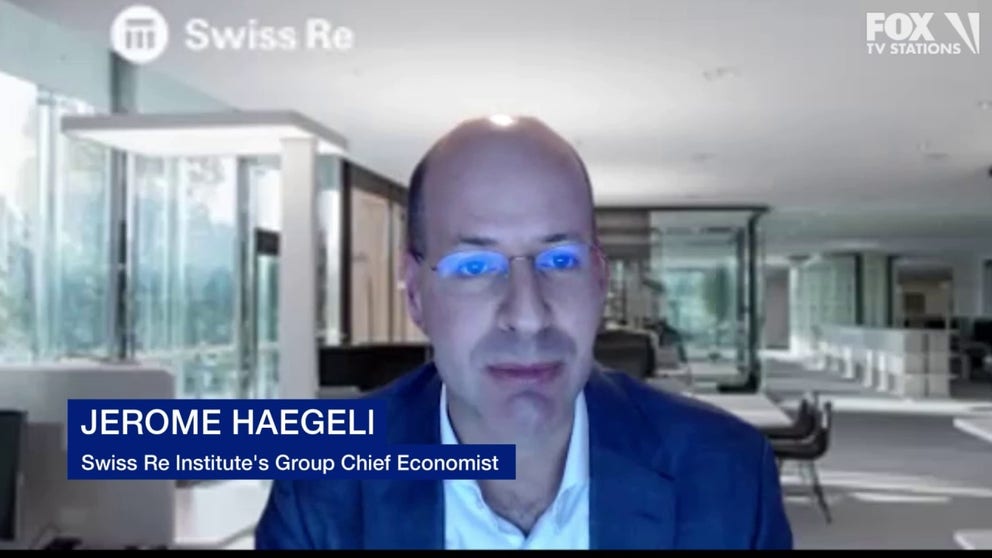Nearly half of US homes at severe or extreme 'climate risk,' report says
If you are considering buying a home or upgrading your current one, take a look at the top cities at risk of wildfire, flood, hurricane wind damage, heat and bad air quality. The risk impacts everything from property values to insurance costs, according to Realtor.com.
How insurers are looking at climate change
Jerome Haegeli, Swiss Re's group chief economist who analyzes economic and insurance market research, shares how the sector is looking at the risks of climate change.
Almost half of all homes in the U.S. are at severe or extreme risk of flood, hurricane winds, wildfires, heat and/or hazardous air quality.
In the 2024 Housing and Climate Risk Report, Realtor.com looked at homes across the nation to analyze which cities had homes at the highest risk of those disasters, which the site calls climate risk.
"Understanding climate risk in the housing market is crucial as these challenges not only jeopardize residential safety but also impact property values, insurance costs, and market stability," the authors of the report wrote.
BUSINESSES AND HOMEOWNERS ARE NOT FINANCIALLY COVERED FOR RECENT WEATHER EXTREMES
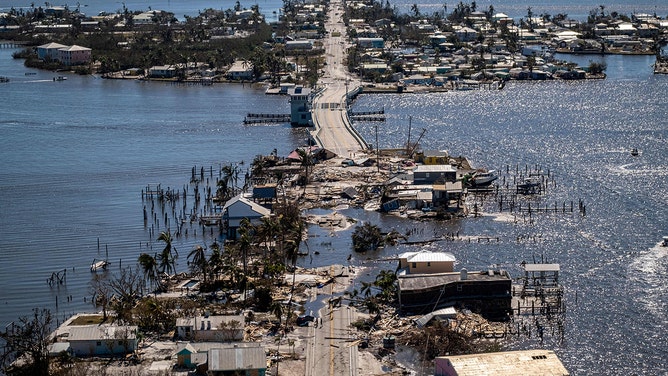
File: An aerial picture taken on September 30, 2022 shows the only access to the Matlacha neighborhood destroyed in the aftermath of Hurricane Ian in Fort Myers, Florida.
(RICARDO ARDUENGO/AFP / Getty Images)
Analysts found that 44.8% of all homes were at severe or extreme risk of at least one disaster. That means almost $22 trillion in investments are threatened. The biggest and growing threats come from heat, wind and air quality. Those three put 40.4% of all American homes at risk. Miami tops several of the lists.
The report ranks cities according to the greatest percentage of homes under each risk, the highest value of homes at risk and top concerns that each homeowner or potential homeowner should keep in mind in high-risk markets. Metro areas are the 100 most populated across the U.S.
Wildfire, heat and air quality risks were calculated by the First Street Foundation. Each home scored a minimum of 7 out of 10 on the risk scale. For example, a home at this level has a high likelihood of damage from severe and/or extreme floods over the next 30 years.
2023 CLAIMS ALL-TIME HIGHEST NUMBER OF BILLION-DOLLAR DISASTERS, NOAA SAYS
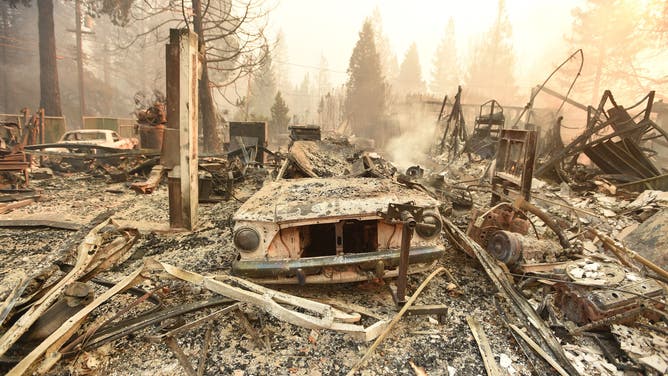
File: The burned remains of a vehicle and home are seen during the Camp fire in Paradise, California on November 8, 2018.
(JOSH EDELSON / AFP / Getty Images)
Severe to extreme heat risk
Almost a third of U.S. homes are at risk of unhealthy heat exposure. Miami tops the list with the highest total value of homes. Every home in that metro area is at extreme or severe risk of this type of weather.
CLIMATE CHANGE ROCKING THE INSURANCE INDUSTRY AND HOMEOWNERS FEEL THE HEAT
The homes face severe or extreme heat exposure when the average monthly maximum heat index in the hottest month of the year is above 95 degrees or will be in 30 years.
"Exposures to severe and extreme heat can significantly increase the cost and frequency of home maintenance expenses on items such as roofs, patios, and retaining walls," the report stated. "Additional costs on HVAC and energy-efficiency system improvements might be required in markets facing heat risks."
Analysts also pointed out 17 other metro areas where 100% of the homes are at heat risk. The areas are in Texas, Louisiana, Florida, South Carolina, North Carolina, Virginia, New York, New Jersey and Pennsylvania.
OVER HALF OF AMERICAN HOMEOWNERS FEAR CLIMATE-RELATED HAZARDS WILL IMPACT HOMES
The 2021 American Housing Survey found that the average amount spent on costly HVAC improvements in Miami was $4,000, which equated to 6% of the owner's annual income. Only 2.8% of homes had solar panels.
In Phoenix, homeowners spent an average of $5,500 or 7% of their annual income on HVAC improvements. Plus, using HVAC raises electric bills for the month.
Severe to extreme wind risk
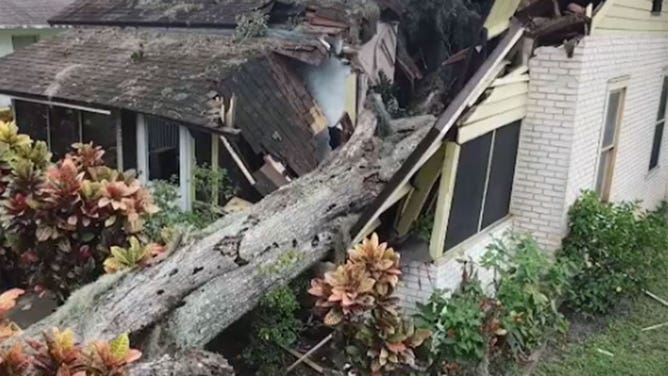
File: Wind blew a tree onto a Daytona Beach, Florida home.
(FOX 35 Orlando)
Miami tops the list for severe to extreme wind risk. That means a home is very likely to experience winds at or above 51 mph during hurricanes. Almost 1 of every 5 homes nationwide faces the risk of wind damage.
TOP 5 COSTLIEST HURRICANES IN US HISTORY
"While homeowner insurance policies generally cover wind damage, nineteen states plus DC allow additional hurricane deductibles," stated the report. "For example, in Louisiana, named storm and hurricane deductibles typically run 2% to 5% of the insured property value.," stated the report.
The report identified 15 metro areas where 100% of the homes face wind risk in Louisiana, Florida, South Carolina, Texas and North Carolina.
HOW ARE HURRICANES RATED? THE SAFFIR-SIMPSON HURRICANE WIND SCALE EXPLAINED
CATEGORY 6 NEEDED ON HURRICANE WIND SCALE DUE TO WARMING CLIMATE, STUDY SAYS
Even with an insurance policy in place, a typical homeowner in Louisiana with a home valued at $242,800 would have to pay $4,856-$12,140 out-of-pocket for hurricane-related property damage.
Severe to extreme air quality/air pollution risk
About 9% of homes across the U.S. are at severe to extreme air quality risk. The San Francisco Bay Area tops the list. California's frequent droughts, wildfires and heat waves are largely at fault.
"Shifts in environmental conditions, including extreme heat, drought, and wildfires, are amplifying the likelihood of heightened air pollution risk," wrote analysts.
These cities have a severe to extreme likelihood of having at least 12 poor air quality days a year.
California and Washington are home to four metro areas in which every home is at risk.
ARE THERE LONG-TERM HEALTH EFFECTS CAUSED BY EXPOSURE TO POOR AIR QUALITY?
"Despite the significant health risks associated with air pollution, some home buyers seem willing to tolerate elevated air quality risk in exchange for access to more affordable homes," said the report.
Realtor.com pointed out that the median price per square foot in inland areas such as Fresno and Stockton were $241 and $299, respectively, compared to $911 and $724 in San Jose and San Francisco, respectively. Coastal communities are cooler and tend to have less stagnant air with sea breezes.
AIR QUALITY INDEX EXPLAINED: WHAT AIR QUALITY IS BAD?
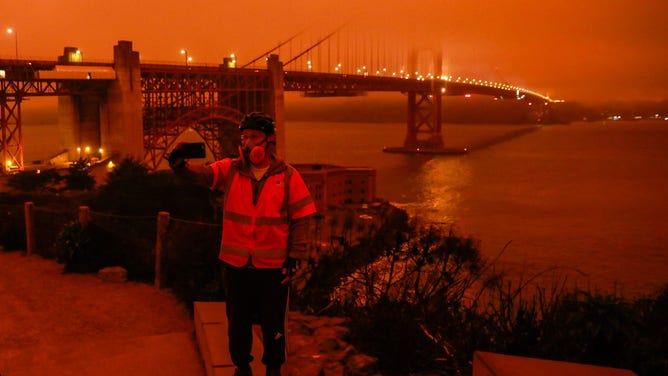
File: Dark orange skies over the Golden Gate Bridge at midday in San Francisco due to smoke from massive wildfires in 2020.
(Gabrielle Lurie/The San Francisco Chronicle via Getty Images / Getty Images)
Severe to extreme flood risk
About 6.6% of American homes are likely to sustain damage from severe to extreme floods over the next 30 years.
"Flood is a widespread climate threat across the top 100 metros, with some properties in each of these markets exposed to severe or extreme flood risks," stated the report.
Not treating property properly after a flood can lead to harmful mold and health issues as well.
PLAN, PREPARE, PROTECT: HOW TO BEST COVER YOUR PROPERTY AGAINST FLOODS
Miami tops the list for the total value of homes at risk. However, several other metro areas of the Sunshine State, Louisiana and South Carolina have vastly more homes at risk at a lower price per home.
WHICH STATES ARE MOST AT RISK FOR FLOODING?
Research showed that homes with higher flood risk generally had a slower price growth. Rising flood insurance premiums will quickly erase the real estate savings from buying a lower-priced home. By law, premiums are capped at an 18% increase for most policyholders, which makes premiums artificially low right now.
"Policyholders of the National Flood Insurance Program, the main provider of flood insurance coverage for U.S. residents, could expect an average of 103% premium increase as soon as four to five years," the report stated.
Realtor.com expects rates to at least double for Mississippi, Louisiana, Florida, Alabama, South Dakota, Oregon, New Hampshire, Missouri and Kentucky.
NOAA: US SEES RECORD NUMBER OF BILLION-DOLLAR WEATHER, CLIMATE DISASTERS IN 2023
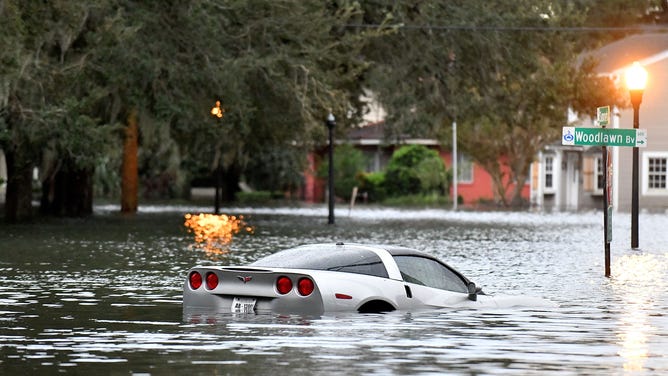
File: A car floating in Hurricane Ian's floodwaters in Orlando.
(Gerardo Mora / Getty Images)
RISING SEA LEVELS TO FLOOD NEARLY 650,000 OCEANFRONT PROPERTIES ACROSS US BY 2025, STUDY FINDS
The highest expected premium rises are in:
- Maine at +183.2%.
- West Virginia at +171.2%.
- Hawaii at +154.1%.
Severe to extreme wildfire risk
About 5.5% of homes are at severe to extreme wildfire risk across the nation, and 39.1% of them are in California. That means homes have a more than 14% chance of being involved in a wildfire over the next 30 years. Los Angeles tops the list.
While the pricey L.A. market tops the dollars at risk list, Colorado, Arizona and other California cities have a greater percentage of homes at risk. Over 76% of homes in Colorado Springs, Colorado, are at risk.
Research shows that the median listing price of homes in high-risk areas has been outpacing prices in low-risk areas, indicating greater demand.
"One important reason behind the stronger demand for risky homes is their affordability," said the report. "However, while buyers may have more affordable home options in these areas, it may become harder and harder to get access to affordable wildfire insurance."
WHAT IS AN ‘INCIDENT METEOROLOGIST’? MEET THIS CRITICAL MEMBER OF WILDFIRE FIGHTS
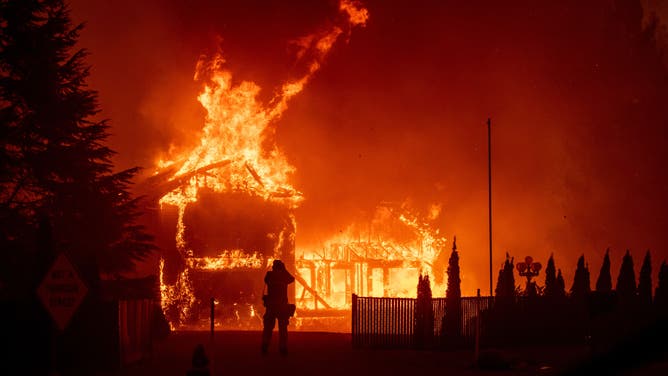
File: The 2018 Camp Fire killed 85 people and destroyed 18,804 structures.
(JOSH EDELSON / AFP / Getty Images)
Several insurance companies have stopped covering homes in California due to the huge and increasing economic losses from wildfires. The state set up a last-resort option for wildfire insurance called the FAIR Plan. It is more expensive than traditional insurance and provides less coverage.
"According to the California Department of Insurance, the FAIR Plan made 21.9% of total policies in 2021 in ten counties with the highest exposure to fire risk, while the share was only 2.2% in 2018," the report stated.
